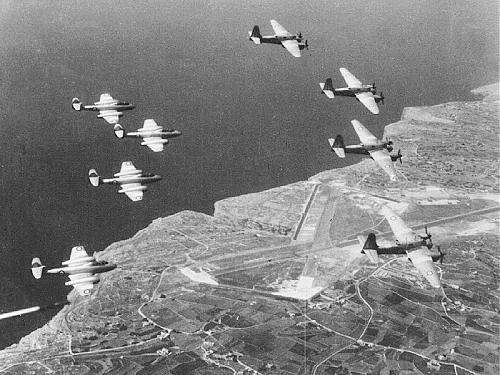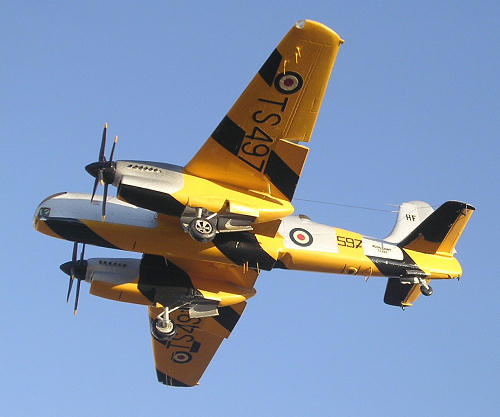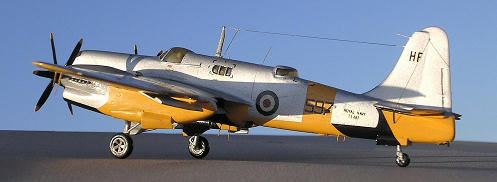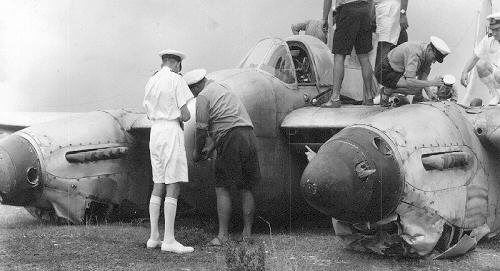Contrail 1/72 Short Sturgeon TT.2
|
KIT #: |
? |
|
PRICE: |
£6.00 |
|
DECALS: |
One Option |
|
REVIEWER: |
Carmel
J. Attard |
|
NOTES: |
Vacform kit with cast white metal props and plastic undercarriage
items |

The Sturgeon was designed as a torpedo
bomber/reconnaissance aircraft for use by the Royal Navy new aircraft carriers
and when submitted to the Admiralty, gained a contract for three prototypes.
However the torpedo carrying requirement soon cancelled and when construction of
the carriers was postponed at the end of WWII, the Sturgeon intended role no
longer existed.
 A
decision was taken to convert it as a high speed target–tug against a new
specification, Q.1/46. Although the first two aircraft were Sturgeon S.A.1 and
Sturgeon S. Mk 1 gunnery trainers with provision for armament, the third became
the S.A. Sturgeon TT Mk2 prototype which resulted in an order for 23 production
aircraft. It featured a contra rotating propeller on two 1660 HP Rolls Royce
Merlin 140 engines. The small diameter propellers allowed close inboard mounting
of the engines which gave a compact form where the wings were folded. The
Sturgeon had a maximum speed of 370mph and could tow a 32ft winged target to an
altitude of 32,000 ft. Some were converted to Sturgeon Mk3 standard which were
used from shore bases mostly in
Malta
operating alongside TT2s. In a bid to make the Sturgeon suitable for
anti-submarine work, the 24th and
last airframe was modified to become the SB3. A deep nose was added, housing a
radome scanner and two operators and it was powered by two 1,475 shp Armstrong
Siddeley Mamba turboprops. Flown in August 1950 it was not a success and the
requirement was met by the Fairey Gannet AEW Mk3.
A
decision was taken to convert it as a high speed target–tug against a new
specification, Q.1/46. Although the first two aircraft were Sturgeon S.A.1 and
Sturgeon S. Mk 1 gunnery trainers with provision for armament, the third became
the S.A. Sturgeon TT Mk2 prototype which resulted in an order for 23 production
aircraft. It featured a contra rotating propeller on two 1660 HP Rolls Royce
Merlin 140 engines. The small diameter propellers allowed close inboard mounting
of the engines which gave a compact form where the wings were folded. The
Sturgeon had a maximum speed of 370mph and could tow a 32ft winged target to an
altitude of 32,000 ft. Some were converted to Sturgeon Mk3 standard which were
used from shore bases mostly in
Malta
operating alongside TT2s. In a bid to make the Sturgeon suitable for
anti-submarine work, the 24th and
last airframe was modified to become the SB3. A deep nose was added, housing a
radome scanner and two operators and it was powered by two 1,475 shp Armstrong
Siddeley Mamba turboprops. Flown in August 1950 it was not a success and the
requirement was met by the Fairey Gannet AEW Mk3.
What
was originally designed as a carrier based strike fighter has became a war
surplus that was then relegated to second line duties. The Short Sturgeon PR Mk1
had a short nose and carried three cameras in a ventral fairing. The TT Mk 2 had
a redesigned narrow long nose that differed from the PR Mk1.
It
was not as popular to spot in British skies as it was over the Mediterranean
apart form its development stage. The Sturgeon had provision for a winch gear
and represented a fast multi-purpose target-tug and gunnery trainer that entered
service with the Fleet Air Arm in 1949 as the TT2.
 All of
the 23 aircraft produced served with 728 Squadron and the Fleet Requirement Unit
at Hal Far airfield in
Malta.
They served into the late 50s which was long enough for me to remember the type
as flying all day long on Target Towing sorties. You could spot the Sturgeon
from anywhere in the clear blue sky with its conspicuous yellow and black
stripes to the undersurface identification colour scheme. At the time the
Sturgeon operated along side a Target Towing Beaufighter which carried out
similar sorties for the Royal Air Force and the local Territorial’s Defense
Battery based at Bahar ic-Caq, near Salini. The Beaufighter operated from the
RAF Luqa airfield. These carried an orange tube like target which when returning
to base was released the target over the airfield to be retrieved by ground
crew. There were occasions when the target drifted outside the airfield
perimeter and vanished within minutes of touching the ground.
All of
the 23 aircraft produced served with 728 Squadron and the Fleet Requirement Unit
at Hal Far airfield in
Malta.
They served into the late 50s which was long enough for me to remember the type
as flying all day long on Target Towing sorties. You could spot the Sturgeon
from anywhere in the clear blue sky with its conspicuous yellow and black
stripes to the undersurface identification colour scheme. At the time the
Sturgeon operated along side a Target Towing Beaufighter which carried out
similar sorties for the Royal Air Force and the local Territorial’s Defense
Battery based at Bahar ic-Caq, near Salini. The Beaufighter operated from the
RAF Luqa airfield. These carried an orange tube like target which when returning
to base was released the target over the airfield to be retrieved by ground
crew. There were occasions when the target drifted outside the airfield
perimeter and vanished within minutes of touching the ground.
I recall aircraft wrecks at a small aircraft scrap
yard at Marsa and a Sturgeon fuselage was among them, others were stacked at a
disused field at Mosta where several fuselages were easily spotted from the main
road past the Mosta Dome in what was then a still unbuilt disused clear area.
This was in the late 50s, a time when the first Meteor TT20s started to arrive
to replace the ageing Sturgeons at Hal Far.
The
Short Sturgeon T2 kit by Contrail is another one from the British aircraft of
the 50s, and at its time was one of the more recent kits by the company to come
out on the market, by which time vacform kits have reached a high standard of
accuracy. A
 comprehensive
instruction sheet contained 4 view scale line drawings, instructions suggesting
a method of construction and 4 very clear photographs of the operational
Sturgeon TT2. There are 32 vacform parts in white plastic and 7 transparent
pieces.
The vacform parts are beautifully
produced and to make things easier Aeroclub of Nottingham cast the contra
rotating propellers in white metal, and the undercarriage legs, exhaust stabs
and wheels for this kit were injected in black plastic. The propellers were of
good quality cast metal items and only a slight clean-up with a smooth file was
all that was required.
comprehensive
instruction sheet contained 4 view scale line drawings, instructions suggesting
a method of construction and 4 very clear photographs of the operational
Sturgeon TT2. There are 32 vacform parts in white plastic and 7 transparent
pieces.
The vacform parts are beautifully
produced and to make things easier Aeroclub of Nottingham cast the contra
rotating propellers in white metal, and the undercarriage legs, exhaust stabs
and wheels for this kit were injected in black plastic. The propellers were of
good quality cast metal items and only a slight clean-up with a smooth file was
all that was required.
The kit contained vacform canopies which were clear
enough to allow a certain amount of detail added inside such as seat straps
instrument panel etc to be visible. The clear nose and cockpit Perspex had the
tendency to turn yellowish with time unfortunately. The main components are
formed out of a white 30 thou sheet which is of suitable thickness for a large
kit as the Sturgeon is. At sharp corners the plastic tended to be thin and at
places like the wing roots required reinforcement. The main parts needed the
cutting, shaping/ sanding with wet and dry in the usual standard procedure
practiced with vacform kits. The parts were excellent in shape and a certain
amount of time was needed to arrive to the correct section width of parts before
the fuselage interior could be added.
I have first scored around the mouldings and snapped
off waste plastic. Components were carefully rubbed down the joining surfaces on
wet and dry paper glued onto a flat board. A thin surface was achieved at the
wing trailing edges, tail planes and rudder before gluing the halves together.
The edges of the moulded nose transparencies were cut and the edges shaped.
Cockpit decking was also cut and small side windows opened with a pointed blade.
Also a section of the lower nose was cut and shaped the front rectangular
windows.
The 4 fuselage bulkheads
were cut and glued in positions as per instructions. The cockpit floor is added
and seats glued to the pilot office and for the winch operator accommodated at
the rear round canopy. The cockpit was painted interior green and instruments in
black with white gauges. Other detail as control column, rudder pedals and side
instruments were added to t he
interior. Small tabs of plastic taken from discarded/waste plastic were cut and
glued at suitable places around the inner edge of one fuselage half. These are
necessary to act as guides when locating the two halves together. The two halves
were checked for correct fit, glued together and set aside to dry.
he
interior. Small tabs of plastic taken from discarded/waste plastic were cut and
glued at suitable places around the inner edge of one fuselage half. These are
necessary to act as guides when locating the two halves together. The two halves
were checked for correct fit, glued together and set aside to dry.
Reference to photos gave
a clear indication of how the flaps would appear when lowered. This was extra
work that I made to the Sturgeon model by lowering the flaps. The flaps were cut
carefully with a sharp X-acto blade and were then glued in lowered position. The
engine nacelles were two separate sub assemblies. These were cut, trimmed,
sanded, and interior structural detail added. The undercarriage door and chin
radiator also cut as per reference drawing given. Two small discs of thick
plastic sheet were cut to fit inside each nacelle. A simulated radiator was made
from scrap, cut to fit 2mm back from chin opening and glued into one half of
each nacelle. Into the top of each nacelle a 1.5mm scrap of plastic was glued
and a hole was drilled to take the undercarriage leg. The two nacelles were then
glued and brought to the corresponding wing openings. A wing spar was cut to
pass through a slot cut in the fuselage sides and into each wing by about 1
inch. The wings are cemented to the wing spar and to the fuselage sides, checked
for alignment and allowed to set. Tail planes and fin were then added to the
fuselage and allowed to set. Filler was added to mall areas around the joint
lines. Finally the nose, cockpit canopy and rear dome were trimmed and fitted to
the fuselage. Side windows were glazed with Kristal Kleer. Undercarriage doors,
legs, exhaust stabs, and antennae were added as the last items to goon the kit.
Being a TT version, wire guards made from thin fishing line was added at
appropriate places to prevent the towing rope from entangling with control
surfaces.
 The
Sturgeon TT2 based at Hal Far, Malta were painted in a standard TT colour scheme
having top and fuselage sides in aluminium, the undersides were trainer yellow
and black diagonal stripes. A yellow band went around the rear fuselage and over
the top surfaces of the wings outboard of the engines. The TT2 production
started at
Belfast in
1949 comprising 24 aircraft with RN serials TS475-498. What appeared to be a
dorsal turret was in fact a camera cupola for target observation. Decals
supplied with the kit were of top quality and all adhered very well. The
markings that came with the kit catered for a TT2 that was based at Hal-Far,
Malta
circa 1958 attached to 728 Squadron with registration TS486/591.
The
Sturgeon TT2 based at Hal Far, Malta were painted in a standard TT colour scheme
having top and fuselage sides in aluminium, the undersides were trainer yellow
and black diagonal stripes. A yellow band went around the rear fuselage and over
the top surfaces of the wings outboard of the engines. The TT2 production
started at
Belfast in
1949 comprising 24 aircraft with RN serials TS475-498. What appeared to be a
dorsal turret was in fact a camera cupola for target observation. Decals
supplied with the kit were of top quality and all adhered very well. The
markings that came with the kit catered for a TT2 that was based at Hal-Far,
Malta
circa 1958 attached to 728 Squadron with registration TS486/591.
 Many may
have been put off when they see a vac-form kit in view of the time and the
little extra effort involved to build the model. With a kit like the Sturgeon
which contained injected and cast components, and with an excellent fit of
parts once prepared, this may not be the case. This kit should be a good
starting point for new comer to vacform. The kit should also appeal to post-war
British aviation enthusiasts.
Many may
have been put off when they see a vac-form kit in view of the time and the
little extra effort involved to build the model. With a kit like the Sturgeon
which contained injected and cast components, and with an excellent fit of
parts once prepared, this may not be the case. This kit should be a good
starting point for new comer to vacform. The kit should also appeal to post-war
British aviation enthusiasts.
Carmel J.
Attard
February 2009
If you would like your product reviewed fairly and quickly, please
contact
me or see other details in the
Note to
Contributors.
Back to the Main Page
Back to the Review
Index Page



 All of
the 23 aircraft produced served with 728 Squadron and the Fleet Requirement Unit
at Hal Far airfield in
All of
the 23 aircraft produced served with 728 Squadron and the Fleet Requirement Unit
at Hal Far airfield in  comprehensive
instruction sheet contained 4 view scale line drawings, instructions suggesting
a method of construction and 4 very clear photographs of the operational
Sturgeon TT2. There are 32 vacform parts in white plastic and 7 transparent
pieces.
The vacform parts are beautifully
produced and to make things easier Aeroclub of Nottingham cast the contra
rotating propellers in white metal, and the undercarriage legs, exhaust stabs
and wheels for this kit were injected in black plastic. The propellers were of
good quality cast metal items and only a slight clean-up with a smooth file was
all that was required.
comprehensive
instruction sheet contained 4 view scale line drawings, instructions suggesting
a method of construction and 4 very clear photographs of the operational
Sturgeon TT2. There are 32 vacform parts in white plastic and 7 transparent
pieces.
The vacform parts are beautifully
produced and to make things easier Aeroclub of Nottingham cast the contra
rotating propellers in white metal, and the undercarriage legs, exhaust stabs
and wheels for this kit were injected in black plastic. The propellers were of
good quality cast metal items and only a slight clean-up with a smooth file was
all that was required. he
interior. Small tabs of plastic taken from discarded/waste plastic were cut and
glued at suitable places around the inner edge of one fuselage half. These are
necessary to act as guides when locating the two halves together. The two halves
were checked for correct fit, glued together and set aside to dry.
he
interior. Small tabs of plastic taken from discarded/waste plastic were cut and
glued at suitable places around the inner edge of one fuselage half. These are
necessary to act as guides when locating the two halves together. The two halves
were checked for correct fit, glued together and set aside to dry. The
Sturgeon TT2 based at Hal Far, Malta were painted in a standard TT colour scheme
having top and fuselage sides in aluminium, the undersides were trainer yellow
and black diagonal stripes. A yellow band went around the rear fuselage and over
the top surfaces of the wings outboard of the engines. The TT2 production
started at
The
Sturgeon TT2 based at Hal Far, Malta were painted in a standard TT colour scheme
having top and fuselage sides in aluminium, the undersides were trainer yellow
and black diagonal stripes. A yellow band went around the rear fuselage and over
the top surfaces of the wings outboard of the engines. The TT2 production
started at  Many may
have been put off when they see a vac-form kit in view of the time and the
little extra effort involved to build the model. With a kit like the Sturgeon
which contained injected and cast components, and with an excellent fit of
parts once prepared, this may not be the case. This kit should be a good
starting point for new comer to vacform. The kit should also appeal to post-war
British aviation enthusiasts.
Many may
have been put off when they see a vac-form kit in view of the time and the
little extra effort involved to build the model. With a kit like the Sturgeon
which contained injected and cast components, and with an excellent fit of
parts once prepared, this may not be the case. This kit should be a good
starting point for new comer to vacform. The kit should also appeal to post-war
British aviation enthusiasts.